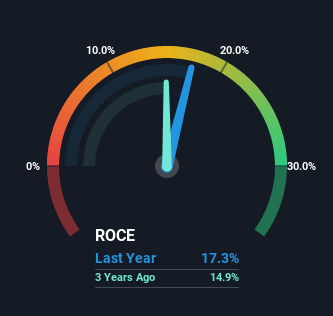InfoBeans Technologies (NSE:INFOBEAN) Will Be Hoping To Turn Its Returns On Capital Around
If we want to find a stock that could multiply over the long term, what are the underlying trends we should look for? Firstly, we'll want to see a proven return on capital employed (ROCE) that is increasing, and secondly, an expanding base of capital employed. Ultimately, this demonstrates that it's a business that is reinvesting profits at increasing rates of return. However, after briefly looking over the numbers, we don't think InfoBeans Technologies (NSE:INFOBEAN) has the makings of a multi-bagger going forward, but let's have a look at why that may be.
Understanding Return On Capital Employed (ROCE)
For those who don't know, ROCE is a measure of a company's yearly pre-tax profit (its return), relative to the capital employed in the business. Analysts use this formula to calculate it for InfoBeans Technologies:
Return on Capital Employed = Earnings Before Interest and Tax (EBIT) ÷ (Total Assets - Current Liabilities)
0.17 = ₹411m ÷ (₹2.5b - ₹154m) (Based on the trailing twelve months to December 2021).
Thus, InfoBeans Technologies has an ROCE of 17%. On its own, that's a standard return, however it's much better than the 12% generated by the Software industry.
See our latest analysis for InfoBeans Technologies

Historical performance is a great place to start when researching a stock so above you can see the gauge for InfoBeans Technologies' ROCE against it's prior returns. If you're interested in investigating InfoBeans Technologies' past further, check out this free graph of past earnings, revenue and cash flow.
What Can We Tell From InfoBeans Technologies' ROCE Trend?
In terms of InfoBeans Technologies' historical ROCE movements, the trend isn't fantastic. To be more specific, ROCE has fallen from 25% over the last five years. However, given capital employed and revenue have both increased it appears that the business is currently pursuing growth, at the consequence of short term returns. If these investments prove successful, this can bode very well for long term stock performance.
What We Can Learn From InfoBeans Technologies' ROCE
In summary, despite lower returns in the short term, we're encouraged to see that InfoBeans Technologies is reinvesting for growth and has higher sales as a result. And the stock has done incredibly well with a 1,083% return over the last three years, so long term investors are no doubt ecstatic with that result. So while investors seem to be recognizing these promising trends, we would look further into this stock to make sure the other metrics justify the positive view.
On a separate note, we've found 1 warning sign for InfoBeans Technologies you'll probably want to know about.
For those who like to invest in solid companies, check out this free list of companies with solid balance sheets and high returns on equity.
New: AI Stock Screener & Alerts
Our new AI Stock Screener scans the market every day to uncover opportunities.
• Dividend Powerhouses (3%+ Yield)
• Undervalued Small Caps with Insider Buying
• High growth Tech and AI Companies
Or build your own from over 50 metrics.
Have feedback on this article? Concerned about the content? Get in touch with us directly. Alternatively, email editorial-team (at) simplywallst.com.
This article by Simply Wall St is general in nature. We provide commentary based on historical data and analyst forecasts only using an unbiased methodology and our articles are not intended to be financial advice. It does not constitute a recommendation to buy or sell any stock, and does not take account of your objectives, or your financial situation. We aim to bring you long-term focused analysis driven by fundamental data. Note that our analysis may not factor in the latest price-sensitive company announcements or qualitative material. Simply Wall St has no position in any stocks mentioned.
About NSEI:INFOBEAN
InfoBeans Technologies
Designs, builds, and manages digital applications in the United Arab Emirates, Germany, India, the United States, and internationally.
Flawless balance sheet with solid track record.
Similar Companies
Market Insights
Community Narratives


Recently Updated Narratives

Constellation Energy Dividends and Growth

CoreWeave's Revenue Expected to Rocket 77.88% in 5-Year Forecast

Bisalloy Steel Group will shine with a projected profit margin increase of 12.8%
Popular Narratives


MicroVision will explode future revenue by 380.37% with a vision towards success


NVDA: Expanding AI Demand Will Drive Major Data Center Investments Through 2026



